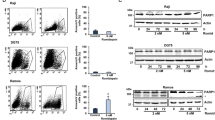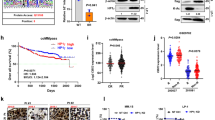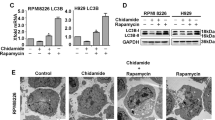Abstract
Histone deacetylase (HDAC) inhibitors, which are approved for the treatment of cutaneous T-cell lymphoma and multiple myeloma, are undergoing evaluation in other lymphoid neoplasms. How they kill susceptible cells is incompletely understood. Here, we show that trichostatin A, romidepsin and panobinostat induce apoptosis across a panel of malignant B cell lines, including lines that are intrinsically resistant to bortezomib, etoposide, cytarabine and BH3 mimetics. Further analysis traces the pro-apoptotic effects of HDAC inhibitors to increased acetylation of the chaperone heat shock protein 90 (HSP90), causing release and degradation of the HSP90 client proteins RASGRP1 and CRAF, which in turn leads to downregulation of mitogen-activated protein kinase pathway signaling and upregulation of the pro-apoptotic BCL2 family member BIM in vitro and in vivo. Importantly, these pro-apoptotic effects are mimicked by RASGRP1 small interfering RNA (siRNA) or HSP90 inhibition and reversed by overexpression of constitutively active MEK1 or siRNA-mediated downregulation of BIM. Collectively, these observations not only identify a new HSP90 client protein, RASGRP1, but also delineate a complete signaling pathway from HSP90 acetylation through RASGRP1 and CRAF degradation to BIM upregulation that contributes to selective cytotoxicity of HDAC inhibitors in lymphoid malignancies.
This is a preview of subscription content, access via your institution
Access options
Subscribe to this journal
Receive 12 print issues and online access
$259.00 per year
only $21.58 per issue
Buy this article
- Purchase on Springer Link
- Instant access to full article PDF
Prices may be subject to local taxes which are calculated during checkout








Similar content being viewed by others
References
Wilcox RA . Cutaneous T-cell lymphoma: 2014 update on diagnosis, risk-stratification, and management. Am J Hematol 2014; 89: 837–851.
Karlin L, Coiffier B . The changing landscape of peripheral T-cell lymphoma in the era of novel therapies. Semin Hematol 2014; 51: 25–34.
Bates SE, Robey RW, Piekarz RL . CCR 20th anniversary commentary: expanding the epigenetic therapeutic portfolio. Clin Cancer Res 2015; 21: 2195–2197.
Fowler N, Oki Y . Developing novel strategies to target B-cell malignancies. ASCO Educational book 2013, 366–372. Available at: http://meetinglibrary.asco.org/sites/meetinglibrary.asco.org/files/EducationalBook/PDFFiles/2013/EdBookAM201333366.pdf.
Mondello P, Younes A . Emerging drugs for diffuse large B-cell lymphoma. Expert Rev Anticancer Ther 2015; 15: 439–451.
Lue JK, Amengual JE, O'Connor OA . Epigenetics and lymphoma: can we use epigenetics to prime or reset chemoresistant lymphoma programs? Curr Oncol Rep 2015; 17: 40.
Smolewski P, Witkowska M, Robak T . Treatment options for mantle cell lymphoma. Expert Opin Pharmacother 2015; 16: 2497–2507.
Morabito F, Recchia AG, Vigna E, De Stefano L, Bossio S, Morabito L et al. Promising therapies for the treatment of chronic lymphocytic leukemia. Expert Opin Investig Drugs 2015; 24: 795–807.
Marks PA . Histone deacetylase inhibitors: a chemical genetics approach to understanding cellular functions. Biochim Biophys Acta 2010; 1799: 717–725.
Zhang J, Zhong Q . Histone deacetylase inhibitors and cell death. Cell Mol Life Sci 2014; 71: 3885–3901.
Yazbeck VY, Grant S . Romidepsin for the treatment of non-Hodgkin's lymphoma. Expert Opin Investig Drugs 2015; 24: 965–979.
Bose P, Dai Y, Grant S . Histone deacetylase inhibitor (HDACI) mechanisms of action: emerging insights. Pharmacol Therap 2014; 143: 323–336.
Walensky LD, Pitter K, Morash J, Oh KJ, Barbuto S, Fisher J et al. A stapled BID BH3 helix directly binds and activates BAX. Mol Cell 2006; 24: 199–210.
Dai H, Smith A, Meng XW, Schneider PA, Pang Y-P, Kaufmann SH . Transient binding of an activator BH3 domain to the Bak BH3-binding groove initiates Bak oligomerization. J Cell Biol 2011; 194: 39–48.
Dai H, Pang Y-P, Kaufmann SH . Evaluation of the BH3-only protein puma as a direct Bak activator. J Biol Chem 2014; 289: 89–99.
Czabotar PE, Westphal D, Dewson G, Ma S, Hockings C, Fairlie WD et al. Bax crystal structures reveal how BH3 domains activate Bax and nucleate its oligomerization to induce apoptosis. Cell 2013; 152: 519–531.
Brouwer JM, Westphal D, Dewson G, Robin AY, Uren RT, Bartolo R et al. Bak core and latch domains separate during activation, and freed core domains form symmetric homodimers. Mol Cell 2014; 55: 938–946.
Earnshaw WC, Martins LM, Kaufmann SH . Mammalian caspases: structure, activation, substrates and functions during apoptosis. Ann Rev Biochem 1999; 68: 383–424.
Taylor RC, Cullen SP, Martin SJ . Apoptosis: controlled demolition at the cellular level. Nat Rev Mol Cell Biol 2008; 9: 231–241.
Llambi F, Moldoveanu T, Tait SW, Bouchier-Hayes L, Temirov J, McCormick LL et al. A unified model of mammalian BCL-2 protein family interactions at the mitochondria. Mol Cell 2011; 44: 517–531.
Strasser A, Cory S, Adams JM . Deciphering the rules of programmed cell death to improve therapy of cancer and other diseases. EMBO J 2011; 30: 3667–3683.
Dai H, Meng XW, Kaufmann SH . BCL2 family, mitochondrial apoptosis, and beyond. Cancer Transl Med 2016; 2: 7–20.
Miyashita T, Reed JC . Bcl-2 oncoprotein blocks chemotherapy-induced apoptosis in a human leukemia cell line. Blood 1993; 81: 151–157.
Yang E, Korsmeyer SJ . Molecular thanatopsis: a discourse on the Bcl2 family and cell death. Blood 1996; 88: 386–401.
Dai H, Meng XW, Lee S-H, Schneider PA, Kaufmann SH . Context-dependent Bcl-2/Bak interactions regulate lymphoid cell apoptosis. J Biol Chem 2009; 284: 18311–18322.
Smith AJ, Dai H, Correia C, Lee S-H, Takahashi R, Kaufmann SH . Noxa/Bcl-2 interactions contribute to bortezomib resistance in human lymphoid cells. J Biol Chem 2011; 286: 17682–17692.
Correia C, Schneider PA, Dai H, Dogan A, Maurer MJ, Church AK et al. BCL2 mutations are associated with increased risk of transformation and shortened survival in follicular lymphoma. Blood 2015; 125: 658–667.
Pasqualucci L, Khiabanian H, Fangazio M, Vasishtha M, Messina M, Holmes AB et al. Genetics of follicular lymphoma transformation. Cell Rep 2014; 16: 130–140.
Insinga A, Monestiroli S, Ronzoni S, Gelmetti V, Marchesi F, Viale A et al. Inhibitors of histone deacetylases induce tumor-selective apoptosis through activation of the death receptor pathway. Nat Med 2005; 11: 71–76.
Frew AJ, Lindemann RK, Martin BP, Clarke CJ, Sharkey J, Anthony DA et al. Combination therapy of established cancer using a histone deacetylase inhibitor and a TRAIL receptor agonist. Proc Natl Acad Sci USA 2008; 105: 11317–11322.
Jazirehi AR, Kurdistani SK, Economou JS . Histone deacetylase inhibitor sensitizes apoptosis-resistant melanomas to cytotoxic human T lymphocytes through regulation of TRAIL/DR5 pathway. J Immunol 2014; 192: 3981–3989.
Fulda S . Histone deacetylase (HDAC) inhibitors and regulation of TRAIL-induced apoptosis. Exp Cell Res 2012; 318: 1208–1212.
Cao XX, Mohuiddin I, Ece F, McConkey DJ, Smythe WR . Histone deacetylase inhibitor downregulation of bcl-xl gene expression leads to apoptotic cell death in mesothelioma. Am J Resp Cell Mol Biol 2001; 25: 562–568.
Wiegmans AP, Alsop AE, Bots M, Cluse LA, Williams SP, Banks KM et al. Deciphering the molecular events necessary for synergistic tumor cell apoptosis mediated by the histone deacetylase inhibitor vorinostat and the BH3 mimetic ABT-737. Cancer Res 2011; 71: 3603–3615.
Xargay-Torrent S, Lopez-Guerra M, Saborit-Villarroya I, Rosich L, Campo E, Roue G et al. Vorinostat-induced apoptosis in mantle cell lymphoma is mediated by acetylation of proapoptotic BH3-only gene promoters. Clin Cancer Res 2011; 17: 3956–3968.
Dai Y, Chen S, Venditti CA, Pei XY, Nguyen TK, Dent P et al. Vorinostat synergistically potentiates MK-0457 lethality in chronic myelogenous leukemia cells sensitive and resistant to imatinib mesylate. Blood 2008; 112: 793–804.
Wahner Hendrickson AE, Meng XW, Kaufmann SH . Anticancer therapy: boosting the bang of Bim. J Clin Invest 2008; 118: 3582–3584.
Pinon JD, Labi V, Egle A, Villunger A . Bim and Bmf in tissue homeostasis and malignant disease. Oncogene 2009; 27: S41–S52.
Ley R, Balmanno K, Hadfield K, Weston C, Cook SJ . Activation of the ERK1/2 signaling pathway promotes phosphorylation and proteasome-dependent degradation of the BH3-only protein, Bim. J Biol Chem 2003; 278: 18811–18816.
Dehan E, Bassermann F, Guardavaccaro D, Vasiliver-Shamis G, Cohen M, Lowes KN et al. betaTrCP- and Rsk1/2-mediated degradation of BimEL inhibits apoptosis. Mol Cell 2009; 33: 109–116.
Cragg MS, Jansen ES, Cook M, Harris C, Strasser A, Scott CL . Treatment of B-RAF mutant human tumor cells with a MEK inhibitor requires Bim and is enhanced by a BH3 mimetic. J Clin Invest 2008; 118: 3582–3584.
Ding H, Hackbarth J, Schneider PA, Peterson KL, Meng XW, Dai H et al. Cytotoxicity of farnesyltransferase inhibitors in lymphoid cells mediated by MAPK pathway inhibition and Bim upregulation. Blood 2011; 118: 4872–4881.
Bali P, Pranpat M, Bradner J, Balasis M, Fiskus W, Guo F et al. Inhibition of histone deacetylase 6 acetylates and disrupts the chaperone function of heat shock protein 90: a novel basis for antileukemia activity of histone deacetylase inhibitors. J Biol Chem 2005; 280: 26729–26734.
Stone JC . Regulation of Ras in lymphocytes: get a GRP. Biochem Soc Trans 2006; 34 (Pt 5): 858–861.
Meng X, Chandra J, Loegering D, Van Becelaere K, Kottke TJ, Gore SD et al. Central role of FADD in apoptosis induction by the mitogen activated activated protein kinase kinase inhibitor CI1040 (PD184352) in acute lymphocytic leukemia cell lines in vitro. J Biol Chem 2003; 278: 47326–47339.
Boehm JS, Zhao JJ, Yao J, Kim SY, Firestein R, Dunn IF et al. Integrative genomic approaches identify IKBKE as a breast cancer oncogene. Cell 2007; 129: 1065–1079.
Kaufmann SH, Svingen PA, Gore SD, Armstrong DK, Cheng Y-C, Rowinsky EK . Altered formation of topotecan-stabilized topoisomerase I-DNA adducts in human leukemia cells. Blood 1997; 89: 2098–2104.
Kaufmann SH . Reutilization of immunoblots after chemiluminescent detection. Analytical Biochem 2001; 296: 283–286.
Karam JA, Fan J, Stanfield J, Richer E, Benaim EA, Frenkel E et al. The use of histone deacetylase inhibitor FK228 and DNA hypomethylation agent 5-azacytidine in human bladder cancer therapy. Int J Cancer 2007; 120: 1795–1802.
Riss TL, Moravec RA, Niles AL, Benink HA, Worzella TJ, Minor L Cell viability assays. In: Sittampalam GS, Coussens NP, Nelson H, Arkin M, Auld D, Austin C et al (eds) Assay Guidance Manual 2004.
Deng J, Carlson N, Takeyama K, Dal Cin P, Shipp M, Letai A . BH3 profiling identifies three distinct classes of apoptotic blocks to predict response to ABT-737 and conventional chemotherapeutic agents. Cancer Cell 2007; 12: 171–185.
Merino D, Khaw SL, Glaser SP, Anderson DJ, Belmont LD, Wong C et al. Bcl-2, Bcl-x(L), and Bcl-w are not equivalent targets of ABT-737 and navitoclax (ABT-263) in lymphoid and leukemic cells. Blood 2012; 119: 5807–5816.
Nguyen M, Marcellus RC, Roulston A, Watson M, Serfass L, Murthy Madiraju SR et al. Small molecule obatoclax (GX15-070) antagonizes MCL-1 and overcomes MCL-1-mediated resistance to apoptosis. Proc Natl Acad Sci USA 2007; 104: 19512–19517.
Vogler M, Weber K, Dinsdale D, Schmitz I, Schulze-Osthoff K, Dyer MJ et al. Different forms of cell death induced by putative BCL2 inhibitors. Cell Death Differ 2009; 16: 1030–1039.
Aron JL, Parthun MR, Marcucci G, Kitada S, Mone AP, Davis ME et al. Depsipeptide (FR901228) induces histone acetylation and inhibition of histone deacetylase in chronic lymphocytic leukemia cells concurrent with activation of caspase 8-mediated apoptosis and down-regulation of c-FLIP protein. Blood 2003; 102: 652–658.
Meng XW, Peterson KL, Dai H, Schneider P, Lee SH, Zhang JS et al. High cell surface death receptor expression determines type I versus type II signaling. J Biol Chem 2011; 286: 35823–35833.
Gupta M, Wahner Hendrickson A, Seongseouk Y, Han JJ, Schneider PA, Stenson M et al. Dual TORC1/TORC2 inhibition diminishes Akt activation and induces puma-dependent apoptosis in lymphoid malignancies. Blood 2012; 119: 476–487.
Shimizu R, Kikuchi J, Wada T, Ozawa K, Kano Y, Furukawa Y . HDAC inhibitors augment cytotoxic activity of rituximab by upregulating CD20 expression on lymphoma cells. Leukemia 2010; 24: 1760–1768.
Byrd JC, Shinn C, Ravi R, Willis CR, Waselenko JK, Flinn IW et al. Depsipeptide (FR901228): a novel therapeutic agent with selective, in vitro activity against human B-cell chronic lymphocytic leukemia cells. Blood 1999; 94: 1401–1408.
Newbold A, Lindemann RK, Cluse LA, Whitecross KF, Dear AE, Johnstone RW . Characterisation of the novel apoptotic and therapeutic activities of the histone deacetylase inhibitor romidepsin. Mol Cancer Ther 2008; 7: 1066–1079.
Acknowledgements
These studies were supported by grants from the Leukemia and Lymphoma Society (6125–10), National Cancer Institute (P50 CA097274, R01 CA166741) and Predolin Foundation. We acknowledge gifts of HSP90 antibody from David Toft as well as romidepsin and 17AAG from the NCI Drug Synthesis Branch.
Author contributions
Conception and design: HD, SHK, GSN. Financial support: SHK. Collection and assembly of data: HD, KLP, CC, BK. Data analysis and interpretation: HD, CC, GSN, SHK. Manuscript writing: All authors. Final approval of manuscript: All authors.
Author information
Authors and Affiliations
Corresponding author
Ethics declarations
Competing interests
The authors declare no conflict of interest.
Additional information
Supplementary Information accompanies this paper on the Leukemia website
Supplementary information
Rights and permissions
About this article
Cite this article
Ding, H., Peterson, K., Correia, C. et al. Histone deacetylase inhibitors interrupt HSP90•RASGRP1 and HSP90•CRAF interactions to upregulate BIM and circumvent drug resistance in lymphoma cells. Leukemia 31, 1593–1602 (2017). https://doi.org/10.1038/leu.2016.357
Received:
Revised:
Accepted:
Published:
Issue Date:
DOI: https://doi.org/10.1038/leu.2016.357
This article is cited by
-
The epigenetic factor CHD4 contributes to metastasis by regulating the EZH2/β-catenin axis and acts as a therapeutic target in ovarian cancer
Journal of Translational Medicine (2023)
-
Targeting CRAF kinase in anti-cancer therapy: progress and opportunities
Molecular Cancer (2023)
-
Phosphorylation of RasGRP1 by Shc3 prevents RasGRP1 degradation and contributes to Ras/c-Jun activation in hepatocellular carcinoma
Molecular and Cellular Biochemistry (2023)
-
A prognostic nomogram integrating novel biomarkers identified by machine learning for cervical squamous cell carcinoma
Journal of Translational Medicine (2020)
-
Role of HDACs in normal and malignant hematopoiesis
Molecular Cancer (2020)



